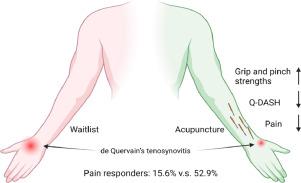Phytomedicine ( IF 7.9 ) Pub Date : 2022-06-14 , DOI: 10.1016/j.phymed.2022.154254 Kinking Leung 1 , Oliver Chunho Ma 1 , Zongshi Qin 2 , Ho Ting 1 , Andrew Hokay Lau 1 , Kevin Kaifung Lun 1 , Hanna Yufaye Chan 1 , Grace Yagun Wen 1 , Jetson Tszkit Ng 1 , Lingfung Chow 1 , Cody Yuenting Chu 1 , Tracy Siuting Ho 1 , Katherine Tsang 1 , Bacon Fung Leung Ng 3 , Margaret Woon Man Fok 4 , Christian Xin Shuo Fang 4 , Lixing Lao 5 , Haiyong Chen 2

|
Background
Acupuncture has been an alternative approach for de Quervain's tenosynovitis (DQt), but trial evidence is still lacking.
Purpose
This study aimed to assess the efficacy of acupuncture in patients with DQt.
Study Design
A randomized controlled trial.
Methods
A total of 68 subjects with DQt were recruited from outpatients of Department of Orthopaedics and Traumatology, and Chinese medicine clinics, The University of Hong Kong, and were randomized into the acupuncture group (n = 34) and the waitlist group (n = 34). Subjects in the acupuncture group received 5 acupuncture sessions over 2 weeks, followed by a 10-week follow-up. The waitlist control group received assessments only in the first 6 weeks of the waiting period and received the same acupuncture treatment and follow-up as the treatment group in the next 12 weeks. The primary outcome was the general pain intensity using the Visual Analogue Scale (VAS) at the end of treatment (week 2). Secondary outcomes were grip and pinch strengths of affected hands, the quick Disabilities of the Arm, Shoulder and Hand Score (Q-DASH), and the World Health Organization Quality of Life-brief Questionnaire (WHOQOL-BREF) at weeks 2 and 6.
Results
From baseline to 2 weeks, the mean VAS score decreased by 19.5 points in the acupuncture group and by 3.4 points in the waitlist group. The difference for acupuncture vs waitlist control was -16.2 points (95% CI, -26.7 to -5.6, p = 0.003). Acupuncture effects sustained for 10 weeks (mean difference compared with baseline, -30.6; 95% CI, -39.6 to -21.7). Secondary outcomes showed that acupuncture reduced pain intensity, improved grip and pinch strength of affected hands, and Q-DASH scores, but not the scores of WHOQOL-BREF in patients. No serious adverse event occurred during the study period.
Conclusions
Our findings support that 2-week of acupuncture is safe and effective in the reduction of pain intensity, and improvement of strengths and disabilities of hand in DQt patients. Acupuncture also has long-term effects on DQt.
Trial registration
This study was registered at clinicaltrials.gov (NCT03472443).



























 京公网安备 11010802027423号
京公网安备 11010802027423号